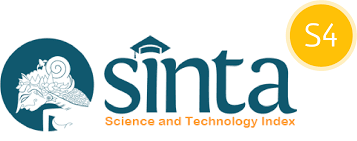Analisa Sentimen Kicauan Twitter Tokopedia Dengan Optimalisasi Data Tidak Seimbang Menggunakan Algoritma SMOTE
DOI:
https://doi.org/10.29408/jit.v5i1.4581Keywords:
Sentiment Analysis, Unbalanced Data, SMOTE, Text Mining, TokopediaAbstract
Along with the development of technology, social media is now often used to provide an assessment, one of which is Twitter is one of the most popular microblogging. On Twitter, users don't just review a product, but they often complain or share their experiences about their level of satisfaction while using Tokopedia. Sentiment analysis on tokopeida provides useful indicators for various purposes which can be found in comments, feedback or criticism. This study uses the Naïve Bayes and Random Forest algorithms to provide the expected classification results, the analysis will be carried out by comparing several combinations of algorithms that will be tested on twitter tweets about Tokopedia, including the combination with Synthetic Minority Oversampling Technique (SMOTE) to optimize unbalanced data. In the Tokopedia Twitter tweet test, SMOTE was able to increase the accuracy of the Naive Bayes algorithm to 86.93%, an increase of 3.4% from the previous 83.53%. Meanwhile, Random Forest with SMOTE has an accuracy value of 88.44%, an increase of 1.55% from the previous Random Forest test of 86.89%.
References
D. Suparto, “Efektivitas Penggunaan Sosial Media Twitter Dalam Penyebaran Informasi Dalam Pelayanan Publik (Studi Kasus Kabupaten Pemalang),” Indones. Gov. J. ( Kaji. Polit. – Pemerintah. ), vol. 04, no. 02, pp. 161–172, 2021.
T. Krisdiyanto, “Analisis Sentimen Opini Masyarakat Indonesia Terhadap Kebijakan PPKM pada Media Sosial Twitter Menggunakan Naïve Bayes Clasifiers,” J. CoreIT J. Has. Penelit. Ilmu Komput. dan Teknol. Inf., vol. 7, no. 1, pp. 32–37, 2021.
P. Arbaini, “Pengaruh Consumer Online Rating Dan Review Terhadap Keputusan Pembelian Pada Pengguna Marketplace Tokopedia,” J. Bisnis dan Manaj., vol. 7, no. 1, pp. 25–33, 2020, doi: 10.26905/jbm.v7i1.3897.
S. Pada, U. Produk, and T. Menggunakan, “Media Informatika Vol.20 No.2 (2021) 97,” vol. 20, no. 2, pp. 97–108, 2021.
K. Ramadhan and K. M. L, “Analisis Sentimen Terhadap Toko Online Menggunakan Naïve Bayes pada Media Sosial Twitter,” e-Proceeding Eng., vol. 5, no. 3, pp. 8141–8151, 2018.
D. P. Artanti, A. Syukur, A. Prihandono, and D. R. I. M. Setiadi, “Analisa Sentimen Untuk Penilaian Pelayanan Situs Belanja Online Menggunakan Algoritma Naïve Bayes,” pp. 8–9, 2018.
I. Saputra, H. E. Darono, F. Amsury, M. R. Fahdia, and B. Ramadhan, “Analisis Sentimen Pengguna Marketplace Bukalapak dan Tokopedia di Twitter Menggunakan Machine Learning,” Fakt. Exacta, vol. 13, no. 4, pp. 200–207, 2020, doi: 10.30998/faktorexacta.v13i4.7074.
A. Sri Widagdo, B. S. W.A, and A. Nasiri, “Analisis Tingkat Kepopuleran E-Commerce Di Indonesia Berdasarkan Sentimen Sosial Media Menggunakan Metode Naïve Bayes,” J. Inf., vol. 6, pp. 1–5, 2020.
M. Wasil, A. Sudianto, and Fathurrahman, “Application of the Decision Tree Method to Predict Student Achievement Viewed from Final Semester Values,” J. Phys. Conf. Ser., vol. 1539, no. 1, 2020, doi: 10.1088/1742-6596/1539/1/012027.
A. Sudianto and M. Wasil, “Penerapan Sistem Informasi Geografis dalam Pemetaan Sebaran Kasus Gizi Buruk Lombok Timur merupakan salah satu Kabupaten yang berada di Provinsi Nusa Tenggara Barat yang terletak di sebelah Timur Pulau Lombok , Kabupaten Lombok Timur Gizi Buruk Malnutrisi,” vol. 4, no. 2, pp. 142–150, 2021.
A. F. Akbar, “User Perception Analysis of Online Learning Platform ‘ Zenius ’ During the Coronavirus Pandemic Using Text Mining Techniques,” vol. 17, no. 2, pp. 33–47, 2021.
Samsir, Ambiyar, U. Verawardina, F. Edi, and R. Watrianthos, “Analisis Sentimen Pembelajaran Daring Pada Twitter di Masa Pandemi COVID-19 Menggunakan Metode Naïve Bayes,” J. Media Inform. Budidarma, vol. 5, no. 1, p. 149, 2021, doi: 10.30865/mib.v5i1.2604.
M. H. N. Yahya, “Penggunaan Algoritma Support Vector Machine (SVM) Untuk Penentuan Kelayakan Pemberian Kredit Koperasi Serba Usaha ‘Daruzzakah Zakah’ Desa Rensing Kecamatan Sakra Lombok Timur Nusa Tenggara Barat,” Infotek J. Inform. dan Teknol., vol. 3, no. 1, pp. 32–41, 2020.
S. Chen, G. I. Webb, L. Liu, and X. Ma, “A novel selective naïve Bayes algorithm,” Knowledge-Based Syst., vol. 192, no. xxxx, p. 105361, 2020, doi: 10.1016/j.knosys.2019.105361.
M. S. Yupi Kuspandi Putra, “Perbandingan Algoritma Naive Bayes dan Naive Bayes Berbasis PSO untuk Analisis Kredit pada PT. BPR Syariah Paokmotong,” Infotek J. Inform. dan Teknol., vol. 2, no. 2, pp. 61–69, 2019.
N. D. Pratama, Y. A. Sari, and P. P. Adikara, “Analisis Sentimen Pada Review Konsumen Menggunakan Metode Naive Bayes Dengan Seleksi Fitur Chi Square Untuk Rekomendasi Lokasi Makanan Tradisional,” J. Pengemb. Teknol. Inf. dan Ilmu Komput. Univ. Brawijaya, vol. 2, no. 9, pp. 2982–2988, 2018.
K. Shah, H. Patel, D. Sanghvi, and M. Shah, “A Comparative Analysis of Logistic Regression, Random Forest and KNN Models for the Text Classification,” Augment. Hum. Res., vol. 5, no. 1, 2020, doi: 10.1007/s41133-020-00032-0.
Hermanto, A. Y. Kuntoro, T. Asra, E. B. Pratama, L. Effendi, and R. Ocanitra, “Gojek and Grab User Sentiment Analysis on Google Play Using Naive Bayes Algorithm and Support Vector Machine Based Smote Technique,” J. Phys. Conf. Ser., vol. 1641, no. 1, 2020, doi: 10.1088/1742-6596/1641/1/012102.
M. P. R. Putra and K. R. N. Wardani, “Penerapan Text Mining Dalam Menganalisis Kepribadian Pengguna Media Sosial,” JUTIM (Jurnal Tek. Inform. Musirawas), vol. 5, no. 1, pp. 63–71, 2020, doi: 10.32767/jutim.v5i1.791.
Downloads
Additional Files
Published
How to Cite
Issue
Section
License
Semua tulisan pada jurnal ini menjadi tanggung jawab penuh penulis. Jurnal Infotek memberikan akses terbuka terhadap siapapun agar informasi dan temuan pada artikel tersebut bermanfaat bagi semua orang. Jurnal Infotek ini dapat diakses dan diunduh secara gratis, tanpa dipungut biaya sesuai dengan lisense creative commons yang digunakan.
Jurnal Infotek is licensed under a Creative Commons Attribution 4.0 International License.
Statistik Pengunjung




